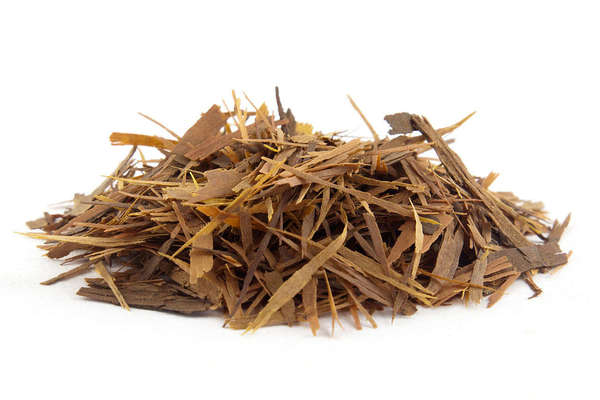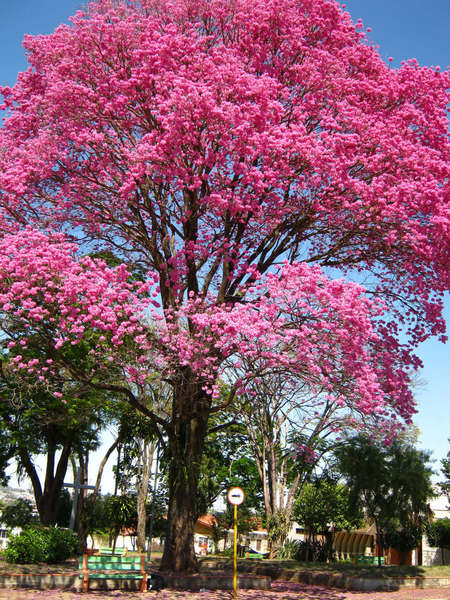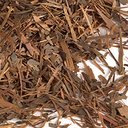Lapacho / Taheebo (Pao d'Arco)
Wikipedia: Lapacho | Teaviews: lapacho-teaLast Updated: Dec. 19, 2016
↑About Lapacho / Taheebo (Pao d'Arco)
 Dried Lapacho, Photo © soultea.de/André Helbig, CC BY-SA 3.0.
Dried Lapacho, Photo © soultea.de/André Helbig, CC BY-SA 3.0."Lapacho" refers to both the tree and the tea, whereas "Taheebo" refers only to the tea. Lapacho is sometimes sold under the name Pau d'arco, which can be misleading because that name also refers to different but closely-related tree species.
The Handroanthus impetiginosus (Pink Trumpet) Tree
 A pink trumpet tree in São Paulo. Photo © Ivolindbergh, Wikimedia Commons, CC BY-SA 3.0.
A pink trumpet tree in São Paulo. Photo © Ivolindbergh, Wikimedia Commons, CC BY-SA 3.0.This tree has a long and diverse history of use by humans. It is widely planted as an ornamental or landscape tree, and is the national tree of Paraguay. The lumber of this tree is valuable, used to make flooring, and the search for this tree is a driving factor of deforestation in the Amazon. The species is also an important honey plant.
Health effects & medicinal use
Although it is sometimes sold as a beverage, lapacho has mainly been used as a medicinal plant, and has been used to treat diabetes, gastric ulcers, and as a pain killer[2], as well as to treat cancer, tumors, and bacterial infections.[1] One of the active ingredients, lapachol, was found to have anti-cancer properties, but was abandoned as a treatment for cancer because of toxic side-effects from a large enough dosage to fight cancer. Lapacho is best used in moderation due to this toxicity. There is evidence of reproductive toxicity in rats.[3]References:
1. J. Rubén Gómez Castellanos, José M. Prieto, Michael Heinrich, Red Lapacho (Tabebuia impetiginosa)—A global ethnopharmacological commodity?, Journal of Ethnopharmacology, Vol. 121, No. 1, Jan. 12, 2009, pp. 1-13.
2. Arvores medicinais - Pau D'arco, University of São Paulo, Retrieved Jan. 21, 2009 (in Portugese)
3. Rita de Cássia da Silveira, Martha de Oliveira Guerra, Reproductive toxicity of lapachol in adult male Wistar rats submitted to short-term treatment, Phytotherapy Research, Vol. 21, No. 7, pp. 658-662.
↑Recent Lapacho Reviews — RSS 

Lapacho (Pao d'archo) Bold Leaf from Upton Tea Imports
Style: Lapacho / Taheebo (Pao d'Arco) – Region: BrazilJan. 21st, 2010
Mild, woody aroma, with a hint of wintergreen. The smell reminds me of the inside of some people's homes...it's a homey, comfortable, familiar sort of smell, but slightly medicinal. This tea is slightly sweet, and very mellow.
After drinking two cups (the sample only really makes three) I'm still not sure how I fe...
↑Top Reviewers
| Rank | User | # | % |
| 1 | 1 | 20 |
Review 2 teas to get on this list!
Advertisement
↑Most-Rated Lapacho

Lapacho (Pao d'archo) Bold Leaf
| Brand: | Upton Tea Imports |
| Style: | Lapacho / Taheebo (Pao d'Arco) |
| Region: | Brazil |
| Caffeine: | Caffeine Free |
| Leaf: | Loose |


